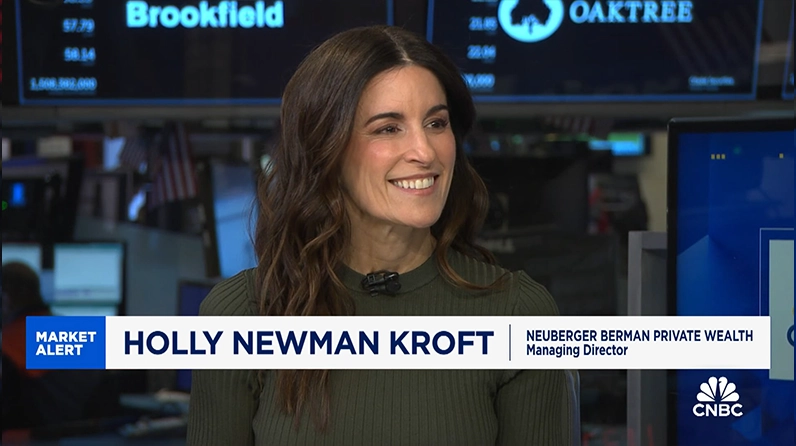

We believe that more recent inflation data has been consistent with our view that a re-acceleration of prices in 2H 2024 is a lower probability and that the path of rates is likely to be in line or lower when compared with the Fed’s current stated expectations.
June’s U.S. CPI was the cool breeze that investors and policymakers were hoping for to cut the heat of the summer and to likely give the Federal Reserve (Fed) the “greater confirmation” it has been seeking as the catalyst to ease policy in 2024. U.S. headline CPI was reported down -0.1% month-over-month and up +3.0% year-over-year, versus expectations of +0.1% and +3.1%, respectively. Core CPI also came in softer than expected, up only +0.1% (rounded from +0.065%) month-over-month and up +3.3% on a year-over-year basis.
The decline in headline CPI for the second month in a row was driven in large part by a drop in gasoline prices, which decreased another -3.8% in June after dropping -3.6% month-over-month in May. Food prices, for their part, were up +0.2% month-over-month in June as four of the six grocery categories were higher in the month. More notable was the increase in food away from home, which rose by +0.4% month-over-month in both May and June, and is up +4.1% year-over-year. We believe this is particularly important as data from food service establishments is indicating a shift toward value consciousness by their customers with continued cost increases potentially resulting in lower traffic and tickets going forward.
Given the volatility in food and energy, the focus, as always, was on the core CPI print, and that came in better than expectations as well. Shelter data finally exhibited some long-anticipated signs of moderation in June, up only +0.2%, with both rent and owners’ equivalent rent (what homeowners could rent their residence for) up +0.3%, levels not seen since August 2021. We believe this is particularly important as shelter is up +5.2% year-over-year and has accounted for nearly 70% of the increase in core CPI over the last 12 months. Also softer were medical care (up only +0.2% month-over-month) and airline fares (down -5% likely on increased competitiveness by carriers to capture the increasing number of summer passengers). Auto prices were also lower with used car prices falling by -1.5% and new cars down -0.2% on a month-over-month basis. Offsetting in small part the improvements were an increase in auto insurance of +0.9% month-over-month and an increase in household furnishings and operations of +0.5%.
Against this backdrop, the past two weeks have seen much discussion of the Fed’s dual mandate. Fed Chair Jerome Powell, in particular, acknowledged that should the disinflationary trend resume, the Fed’s attention would pivot to the state of the U.S. labor market. While the labor market has admittedly shown signs of softening recently, jobless claims released this morning came in lower than expected at +222k versus +236k. We believe that more recent inflation data has been consistent with our view that a reacceleration of prices in the second half of 2024 is a lower probability, and that the path of rates, if indexed more strongly to the labor market, is likely to be in line or lower when compared with the Fed’s current stated expectations. We believe there will be two rate cuts in 2024; the Fed’s dot plot, released in June, currently points to only one.
Not surprisingly, Treasury yields are meaningfully lower across the board following the release. While this news was well received by U.S. equity markets, stocks were trading close to flat mid-morning following a strong move higher thus far in July. The CME FedWatch tool is now reflecting an over 80% probability that the Fed delivers a rate cut in September.


Accolades
Our Advisors Ranked in “Barron’s Top 1,200 Financial Advisors” List for 2025

INSIGHTS
CIO Notebook: Light U.S. Payrolls Close Out a Noisy Week

MARKET COMMENTARY
Trade Debates While Markets Rotate

INSIGHTS
U.S. Tariffs Hit Markets as Growth Questions Emerge

VIDEO
Holly Newman Kroft Joined CNBC to Discuss Market Outlook

Accolades
Forbes | SHOOK 2025 Top Women Wealth Advisors

INSIGHTS
CIO Notebook: Hotter Inflation Creates Doubt for Investors
INSIGHTS
CIO Notebook: January Payrolls Light but U.S. Labor Market Still Strong
MARKET COMMENTARY
Return of the Headlines
INSIGHTS
CIO Notebook: Trump Comes Out Swinging on Trade
INSIGHTS
CIO Notebook: Fed Holds Rates Steady as Powell Promotes Patience
REPLAY
Private Wealth Investment Outlook 1Q25
INSIGHTS
Private Markets: As The Ice Breaks
IMPORTANT INFORMATION:
This material is provided for informational purposes only and nothing herein constitutes investment, legal, accounting or tax advice, or a recommendation to buy, sell or hold a security. This material is general in nature and is not directed to any category of investors and should not be regarded as individualized, a recommendation, investment advice or a suggestion to engage in or refrain from any investment-related course of action. Any views or opinions expressed may not reflect those of the firm as a whole. Neuberger Berman products and services may not be available in all jurisdictions or to all client types. Diversification does not guarantee profit or protect against loss in declining markets. Investing entails risks, including possible loss of principal. Investments in private equity are speculative and involve a higher degree of risk than more traditional investments. Investments in private equity are intended for sophisticated investors only. Unless otherwise indicated, returns shown reflect reinvestment of dividends and distributions. Indexes are unmanaged and are not available for direct investment. Investing entails risks, including possible loss of principal. Past performance is no guarantee of future results.
Portfolio positioning views expressed herein are those of Neuberger Berman’s Private Wealth Investment Group, which may include those of the Neuberger Berman’s Asset Allocation Committee. Asset allocation and positioning views are based on a hypothetical reference portfolio. The Private Wealth Investment Group analyzes market and economic indicators to develop asset allocation strategies. The Private Wealth Investment Group works in partnership with the Office of the CIO. The Private Wealth Investment Group also consults regularly with portfolio managers and investment officers across the firm. The Asset Allocation Committee is comprised of professionals across multiple disciplines, including equity and fixed income strategists and portfolio managers. The Asset Allocation Committee reviews and sets long-term asset allocation models, establishes preferred near-term tactical asset class allocations and, upon request, reviews asset allocations for large diversified mandates. Asset Allocation Committee members are polled on asset classes and the positional views are representative of an Asset Allocation Committee consensus. The views of the Asset Allocation Committee and the Private Wealth Investment Group may not reflect the views of the firm as a whole and Neuberger Berman advisers and portfolio managers may take contrary positions to the views of the Asset Allocation Committee or the Private Wealth Investment Group. The Asset Allocation Committee and the Private Wealth Investment Group views do not constitute a prediction or projection of future events or future market behavior. Defensive positioning generally means an underweight bias on allocations to risk assets such as equities and alternatives. Positioning views may change over time without notice and actual client positioning may vary significantly. Discussion of yield characteristics or total returns of different asset classes are for illustrative purposes only. Such asset classes, such as equities and fixed income, may have significantly different overall risk-return characteristics which should be consider before investing.
The information in this material may contain projections, market outlooks or other forward-looking statements regarding future events, including economic, asset class and market outlooks or expectations, and is only current as of the date indicated. There is no assurance that such events, outlook and expectations will be achieved, and actual results may be significantly different than that shown here. The duration and characteristics of past market/economic cycles and market behavior, including any bull/bear markets, is no indication of the duration and characteristics of any current or future be market/economic cycles or behavior. Information on historical observations about asset or sub-asset classes is not intended to represent or predict future events. Historical trends do not imply, forecast or guarantee future results. Information is based on current views and market conditions, which will fluctuate and may be superseded by subsequent market events or for other reasons.
Discussions of any specific sectors and companies are for informational purposes only. This material is not intended as a formal research report and should not be relied upon as a basis for making an investment decision. The firm, its employees and advisory accounts may hold positions of any companies discussed. Nothing herein constitutes a recommendation to buy, sell or hold a security. It should not be assumed that any investments in securities, companies, sectors or markets identified and described were or will be profitable. Investment decisions and the appropriateness of this content should be made based on an investor's individual objectives and circumstances and in consultation with his or her advisors.
Neuberger Berman Investment Advisers LLC is a registered investment adviser.
The “Neuberger Berman” name and logo are registered service marks of Neuberger Berman Group LLC